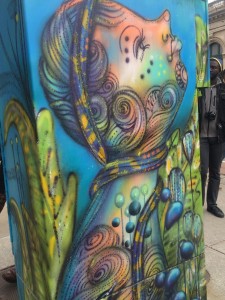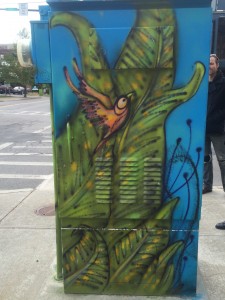Last Wednesday, I attended the final Becker-Rose Café Series of the semester. Representatives of the Cornell Food & Brand Lab came to speak – David Just, Co-Director, Adam Brumberg, Researcher Specialist, and Gnel Gabrielyan, Post-doc Researcher. The researchers have different focus areas and target groups, but it seems that their main goals are to interdisciplinarily merge the fields of nutrition, behavior economics, and psychology, just to name a few.
For the past two semesters, I have walked past the Food & Brand Lab’s display cases in Warren Hall multiple times a week. It is hard not to notice the colorful posters and TV monitors documenting some of their experiments. There is one display in particular that always catches my eye. It is the one showing two-equally sized cookies with one on a larger plate and one on a smaller plate. A card above the plates reads, “Which one makes the cookie look larger?” Perhaps I am always a bit hungry when or walking by, or maybe it is the fact that the researchers look into really interesting questions like this one, but I always manage to take a glimpse of the display.
David, Adam, and Gnel shared some examples of studies that they have conducted and the outcomes of their results. For example, the simple act of placing large arrows on the ground directing grocery store shoppers to the produce section of the store actually resulted in the stores produce sales going up. It was a win-win because the grocery store then made more money selling produce and shoppers were purchasing more healthful foods. Another example that I found to be really neat was on buffet behavior. The “all-you-can-eat” probably gives some indication of what restaurant patrons will do at a buffet. However, there are ways to curb some of the eating, while still enjoying the buffet-style setting. One such method is to survey all of the food options first, then start filling up your plate. Another such method is to sit facing away from the food. Having noticed the increased listing of calories especially in fast food restaurants, I was fascinated to find out that having the calories displayed on menus can actually be detrimental to a person’s eating behavior. They may either ignore the calories or try to get their money’s worth instead.
A major theme that was raised was that of choice. Choice implies conscious decision-making. When we make a decision, the brain can feel happy because it knows that it made that choice. For instance, the researchers discussed how students did not really eat their carrots when given to them without a choice with their school lunch. However, when they were able to choose between carrots and celery, they more often chose the carrots and ate more of them. The act of choosing made a difference. The researchers seem to focus on the general population when they design their experiments, which makes sense. This made me think about those who cannot afford the luxury of such choices, whether it be for financial reasons, access reasons, etc. How would not being able to choose affect their eating habits and behavior or even their attitudes and perception towards food? We have a wonderful dining program at Cornell with numerous options. I think that it is easy to take this for granted.
The next time you are in a dining hall, try using a smaller plate. Also, definitely check out the Food & Brand Lab’s display in Warren Hall! The Lab has done so much influential work, such as apple slices and milk in Happy Meals. I wonder what they are going to study next!


